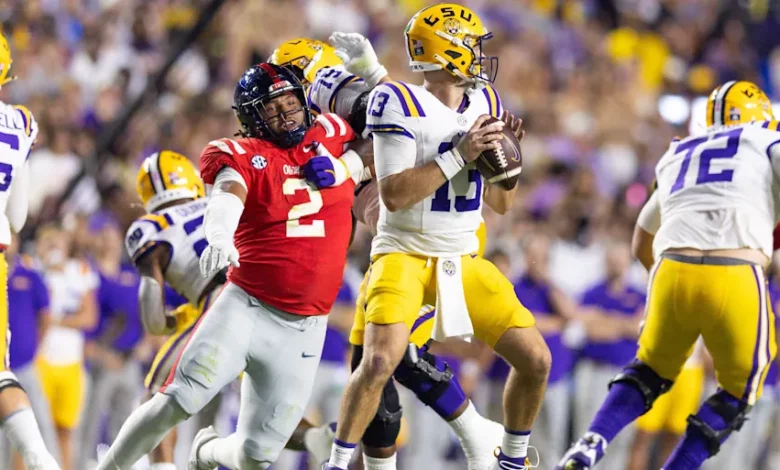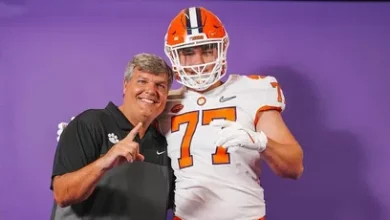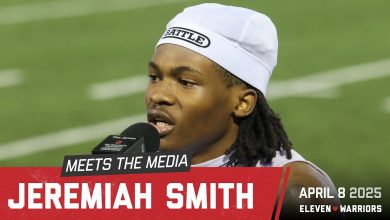In this trade scenario, Matthew Stafford is acquired by the Vikings with a first-round pick. Thank you, but no!

The Minnesota Vikings have long been searching for the elusive piece to elevate them to a Super Bowl contender. Over the years, they’ve cycled through quarterbacks like Kirk Cousins, Teddy Bridgewater, and Sam Bradford, among others, but the question remains: can they find the right quarterback to push them over the top? In a hypothetical trade scenario that has stirred discussion, the Vikings are reportedly interested in acquiring Matthew Stafford from the Los Angeles Rams in exchange for a first-round draft pick.
At first glance, this trade may seem appealing. Stafford, the former No. 1 overall pick, led the Rams to a Super Bowl championship in 2022, proving that he still has the ability to perform at a high level. With his experience and proven track record in the NFL, it would be easy to imagine him stepping into the Vikings’ offense and immediately providing the veteran presence needed to push Minnesota into the upper echelons of the NFC. However, upon closer inspection, this trade proposal raises several red flags for the Vikings—red flags that should make them strongly reconsider the idea of giving up a first-round pick for Stafford.
While Stafford has had an accomplished career, it’s important to evaluate the implications of such a trade for the Vikings both in the short term and the long term. For a team like the Vikings, whose window for championship contention is rapidly closing, the decision to trade away a first-round pick for a quarterback on the tail end of his career may not be the most prudent move. Here’s why the Vikings should firmly say, “Thank you, but no!”
1. Age and Declining Play: Stafford’s Best Years Are Behind Him
At 36 years old, Matthew Stafford is no longer the same quarterback who was once regarded as one of the most talented arms in the league. Although he led the Rams to a Super Bowl victory just a few seasons ago, Stafford’s recent seasons have shown signs of decline. In 2023, he struggled with injuries, including a back issue that severely limited his effectiveness. Even when healthy, his performances were inconsistent, and his ability to elevate the team diminished.
For the Vikings, trading a first-round pick for a player in his mid-30s is a gamble that could easily backfire. The Vikings are not one quarterback away from being Super Bowl contenders; they have multiple holes across their roster that need to be filled, particularly on defense and the offensive line. While Stafford could certainly provide a solid, experienced presence for a few seasons, the Vikings need a long-term solution at quarterback to build a sustainable championship contender. If Stafford’s play continues to decline, or if his injury history becomes more of a concern, the Vikings could end up with an aging quarterback who doesn’t provide the stability and future that they desperately need.
Instead of trading away a valuable first-round pick for a player nearing the end of his career, the Vikings should focus on developing their future at quarterback, whether that’s with J.J. McCarthy, who could be their young quarterback of the future, or by making a move for a younger, more dynamic option. A long-term solution is more important than attempting to plug a short-term hole with Stafford.
2. High Financial Costs: Stafford’s Contract Strains the Cap
One of the significant obstacles in trading for Stafford is his hefty contract. In 2025, Stafford is due to make $47.5 million in base salary, which could cripple the Vikings’ salary cap flexibility. The Vikings already have a roster with several high-salary players, including Justin Jefferson and Dalvin Cook, and taking on Stafford’s massive contract would significantly limit their ability to make other moves in free agency or retain important players.
With Minnesota’s cap situation already tight, trading for Stafford would only exacerbate the issue. The Vikings would have limited flexibility to make improvements to other areas of the team, such as their offensive line, secondary, or pass rush. The NFL is a salary-cap league, and teams that overextend themselves financially often struggle to build a well-rounded roster. The Vikings would be putting all their chips on Stafford, hoping he can be a short-term savior, but in doing so, they could jeopardize their future by tying up a large chunk of their cap space in an aging, expensive quarterback.
Instead, the Vikings should look for ways to free up cap space and invest in young talent that can grow with the team. With J.J. McCarthy potentially in the wings, the Vikings have the opportunity to develop a quarterback on a rookie contract—providing them with far more financial flexibility and enabling them to build a more balanced roster over time.
3. Draft Capital: Why Giving Up a First-Round Pick Hurts Long-Term Planning
A first-round pick is one of the most valuable assets a team can possess. It provides the opportunity to acquire a top-tier player, whether it’s a future superstar or a young quarterback who could become the face of the franchise for the next decade. Giving up that pick for a player like Stafford doesn’t align with the long-term vision of a team like the Vikings, who are in a position to rebuild and build for the future.
Instead of using the first-round pick to bolster their roster with a young, cost-controlled player, trading it for Stafford would limit the team’s ability to add crucial pieces to the puzzle. The Vikings are a team that needs to improve in several areas—particularly on the offensive line and defense—and a first-round pick is crucial to achieving that. Even if Stafford delivers for a year or two, what happens when his play inevitably starts to decline further? The Vikings could be left with little in the way of draft capital and no young, exciting player to help lead them into the future.
Moreover, the 2025 draft class could feature talented quarterbacks, pass rushers, or cornerbacks that could give the Vikings a chance to land a future star. Rather than paying a premium for Stafford, the Vikings should focus on investing in young players who can contribute immediately and provide a foundation for long-term success.
4. The Need for Long-Term Stability: McCarthy’s Development
The Vikings may already have the future of their quarterback position on the roster in J.J. McCarthy. The young quarterback, a standout at the University of Michigan, has shown the kind of tools that could eventually make him the Vikings’ next franchise signal-caller. But for McCarthy to reach his full potential, he needs time to develop. This includes not just the mental and physical aspects of the game but also the opportunity to sit behind a veteran and learn the ropes.
By trading for Stafford, the Vikings would risk stunting McCarthy’s development. If McCarthy is forced to sit on the bench for a prolonged period behind Stafford, it could delay his growth and reduce the chances that he becomes the player the Vikings need him to be. Additionally, the presence of Stafford could lead to quarterback controversy or create unnecessary pressure on McCarthy to start before he’s fully ready.
Rather than investing in an aging quarterback, the Vikings should allow McCarthy to continue developing without rushing his timeline. They can provide him with the mentorship of an established backup quarterback without committing to a costly and potentially damaging trade for Stafford. The long-term success of the franchise is far more important than the possibility of a short-term Super Bowl run with an aging quarterback.
5. The Risk of Struggling in a Competitive NFC North
The NFC North is a highly competitive division, with the Detroit Lions improving rapidly and the Green Bay Packers continuing to be a tough opponent, even after Aaron Rodgers’ departure. The Vikings already have a challenge ahead of them to stay atop the division, especially given their aging roster and lack of long-term stability at quarterback. Adding Stafford may provide a temporary boost, but it’s unlikely to push them past the other NFC North teams in the long run.
Stafford is a seasoned veteran, but the Vikings’ roster still needs significant work. The team will continue to face tough competition within the division and from other NFC contenders, and Stafford may not be the solution to leapfrog those teams. In fact, his age and injury concerns may further hinder the Vikings’ ability to compete at the highest level.
Thank You, But No!
While Matthew Stafford has had a successful career and has proven himself to be a capable quarterback, trading a first-round pick for him would be a risky move for the Minnesota Vikings. Stafford’s age, declining play, massive contract, and the financial constraints that would come with acquiring him are all significant concerns. The Vikings need to prioritize long-term stability and growth, not just short-term solutions that could have diminishing returns.
Instead of gambling on Stafford, the Vikings should focus on developing their young talent, particularly J.J. McCarthy, and use their first-round pick to build a well-rounded, sustainable roster that can compete for years to come. Acquiring Stafford would be a move that sacrifices the future for the present, and for a team with as many roster needs as the Vikings, that’s simply not the right direction.
In this case, the Vikings should stick to their long-term vision and say, “Thank you, but no!” when it comes to trading for Stafford. The best path forward is one that invests in youth, flexibility, and sustainability—building a team that can compete for championships not just for one or two seasons, but for the next decade.









